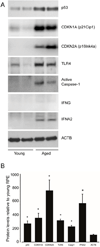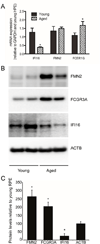Genomic regulation of senescence and innate immunity signaling in the retinal pigment epithelium
- PMID: 25963977
- PMCID: PMC4450138
- DOI: 10.1007/s00335-015-9568-9
Genomic regulation of senescence and innate immunity signaling in the retinal pigment epithelium
Abstract
The tumor suppressor p53 is a major regulator of genes important for cell cycle arrest, senescence, apoptosis, and innate immunity, and has recently been implicated in retinal aging. In this study we sought to identify the genetic networks that regulate p53 function in the retina using quantitative trait locus (QTL) analysis. First we examined age-associated changes in the activation and expression levels of p53; known p53 target proteins and markers of innate immune system activation in primary retinal pigment epithelial (RPE) cells that were harvested from young and aged human donors. We observed increased expression of p53, activated caspase-1, CDKN1A, CDKN2A (p16INK4a), TLR4, and IFNα in aged primary RPE cell lines. We used the Hamilton Eye Institute (HEI) retinal dataset ( www.genenetwork.org ) to identify genomic loci that modulate expression of genes in the p53 pathway in recombinant inbred BXD mouse strains using a QTL systems biology-based approach. We identified a significant trans-QTL on chromosome 1 (region 172-177 Mb) that regulates the expression of Cdkn1a. Many of the genes in this QTL locus are involved in innate immune responses, including Fc receptors, interferon-inducible family genes, and formin 2. Importantly, we found an age-related increase in FCGR3A and FMN2 and a decrease in IFI16 levels in RPE cultures. There is a complex multigenic innate immunity locus that controls expression of genes in the p53 pathway in the RPE, which may play an important role in modulating age-related changes in the retina.
Figures





References
-
- Baggetta R, De Andrea M, Gariano GR, Mondini M, Ritta M, Caposio P, Cappello P, Giovarelli M, Gariglio M, Landolfo S. The interferon-inducible gene IFI16 secretome of endothelial cells drives the early steps of the inflammatory response. Eur. J. Immunol. 2010;40:2182–2189. - PubMed
Publication types
MeSH terms
Substances
Grants and funding
LinkOut - more resources
Full Text Sources
Other Literature Sources
Medical
Molecular Biology Databases
Research Materials
Miscellaneous

